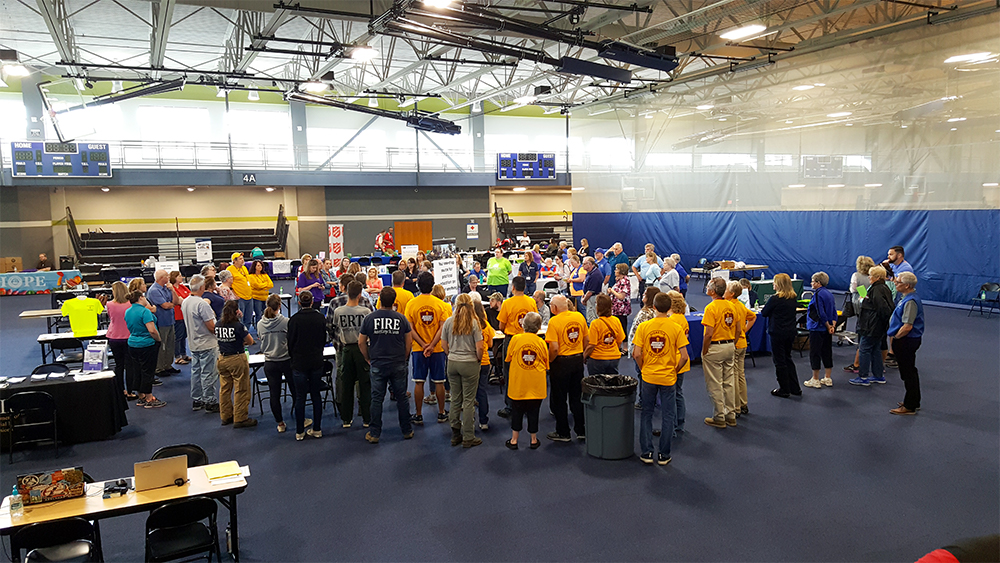This spring the Midwest experienced unprecedented levels of rain, resulting in one of the longest lasting Mississippi floods in our generation. The river didn’t reach record-breaking height levels, but it has shattered all its length of time records for being at or above flood stage. As of July 1, the Mississippi River was at or above flood stage for 107 consecutive days, breaking the previous record of 104 days in 1993.
As flood waters from the Mississippi River moved outside its banks, rose up flood walls and crept across fields and valleys, millions of acres of farmland were covered, bringing many farms to a devastating halt, putting levies and communities at risk, covering roadways and causing mass evacuations.
While Missouri saw devastation from the Mississippi River, other states saw disaster from their own waterways. And although catastrophe has cut many people down, church families in Mid-America have been able to help each other—and their communities—up again.
Dam breach leads to Stuff the Bus event
On March 14, due to high levels of precipitation combined with snowmelt and ice breakage affecting the Niobrara River, the Spencer Dam was breached in the early morning hours. The dam breach resulted in an 11-foot wall of water that destroyed or damaged everything in its path, including homes, roads, bridges and businesses. The water pipeline running beneath the Niobrara River bed was destroyed as well, and the affected 2,000 citizens are without potable water—and expected to remain without water until Christmas.
Since the breach, there have been manhunts to find missing persons, cleanups to bring homes and basements back to functionality, water trucks bringing in water from nearby farm wells, and rebuilds.
Rolling in just days after the disaster, however, was a group of Christians from Skyview Learning Academy near Lincoln, Nebraska. The dam breach occurred early on a Thursday, and by Saturday morning at 8 am, Mick and Michele Ray, founders and administrators of Skyview Learning Academy, were at a local Super Saver grocery store with a 72-passenger bus and eight volunteers.
They planned a Stuff the Bus event, advertised it for one day, and showed up early Saturday morning. By 10 am, the bus was half-filled, and they were calling for more help.
Throughout the day, volunteers from local churches, friends, colleagues and even strangers trucked donations to a nearby staging area as carts filled with donations came in. Volunteers accepted, sorted, and moved goods ranging from cases of bottled water, paper towels, toothbrushes and more piece by piece with no pallets and no forklifts. Thanks to local television and radio stations, the community of Lincoln had a tangible way to help the people of Lynch, Nebraska, the rural town selected to receive the goods.
By the end of the first day, one load of supplies went to Lynch in a single pickup truck pulling an enclosed trailer. The next day they were ready to send a semi-trailer full.
Students of all ages helped load and unload donations, fill semis, haul cases of water and more. Together with Lynch residents, the Skyview team unloaded and organized goods, building friendships with complete strangers.
When the community of Lynch was overwhelmed with donations, they were sent to neighboring communities, including Spencer, for which the dam was named.
A week after the dam breach, Michele Ray approached a local Menards home improvement store and was given permission to host a donation event at their location. This began the push for rebuilding materials for the affected communities.
By the end of May two semi loads of carpeting were sent to Nebraska communities, following sheetrock, work equipment, and retail gift cards to help the community work toward normalcy.
The Rays laugh when looking back on this project, which began as a quick brainstorm and rapidly grew into something larger than either of them expected. Together they reminisce about how many aspects of the whole project were only made possible through God’s will.
Some of the drivers were people they had never met and didn’t even know their names. Many of the cash donations were pressed into their hands by strangers in a supermarket.
From that first idea to the companies and crews who volunteered time, equipment and products, God’s work was seen by everyone.
In all, 222,000 pounds of disaster relief items were collected and distributed and $4,000 was donated to the Lynch Volunteer Fire Department.
Partnerships benefit residents after Missouri tornadoes and floods
The same conditions which led the Niobrara River to swell and breach the Spencer Dam also wreaked havoc in Missouri and Kansas. Rains that came often and heavy left Missouri Adventist Community Services director Jody Dickhaut very busy last spring. Missouri ACS Disaster Relief has participated in various efforts to benefit flood and tornado victims since April, including multi-agency resource centers in Rock Port, St. Joseph, and Mound City, Missouri, where they have served over 1,200 families.
In addition, the Greentree Christian Church in Rolla, Missouri, collected enough water and personal care items to put together 300 kits for Jefferson City victims. These kits include everything a person needs to care for their personal hygiene for a number of days.
Jefferson City mayor Carrie Tergin traveled to the Iowa-Missouri camp meeting to express thanks on behalf of the capital city for the disaster relief efforts of the Adventist Church. During the camp meeting week, everyone in attendance was able to help by bringing items with them which the youth department assembled into 250 flood cleanup buckets.
Adventist Community Services also made the news in June when the Inside the Walls concert was canceled at the Missouri State Penitentiary after tornado damage made the event impossible. In its place, Missouri ACS partnered with the United Way to collect donations at the Jaycee Fairgrounds.
The MOACSDR team, led by Dickhaut, is one of the most active ACS departments in the Mid-American Union and often works with other relief agencies to reach the most people. One example of this partnership is a distribution and donation site in Jefferson City that continued to serve tornado victims in Central Missouri from late May until mid-July.
To date, the MOACSDR operations have secured nearly $750,000 in donated items to help Cole and Miller county residents in the wake of flooding and tornadoes this spring and summer.
At this point in the process, agencies begin to move from relief to recovery, focusing on whatever the people need to rebuild and recover, just like those in the Nebraska flooding.
We have this hope
When someone loses all they have on this earth, when health is threatened, or when disaster strikes, whether through natural order or at the hands of men, you have an opportunity to show God’s love too. You may be the hope that your neighbor needs to see after their personal or public disaster.
Rachel Ashworth lives in Sikeston, Missouri, and regularly writes on a variety of topics for outlookmag.org.










